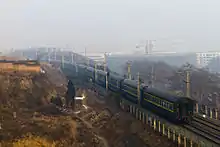The New Eurasian Land Bridge, also called the Second or New Eurasian Continental Bridge, is the southern counterpart to the Eurasian Land Bridge and runs through China and Central Asia with possible plans for expansion into South and West Asia. The Eurasian Land Bridge system is important as an overland rail link between China and Europe, with transit between the two via Central Asia and Russia. In the light of the Russia-Ukraine war, China halted further investments in the part of the bridge that was planned to go through Russia.[1]
Routes
Due to a break-of-gauge between standard gauge used in China and the Russian gauge used in the former Soviet Union countries, containers must be physically transferred from Chinese to Kazakh railway cars at Dostyk on the Chinese–Kazakh border and again at the Belarus–Poland border where the standard gauge used in western Europe begins. This is done with truck-mounted cranes.[2] Chinese media often states that the New Eurasian Land/Continental Bridge extends from Lianyungang to Rotterdam, a distance of 11,870 kilometres (7,380 mi). The exact route used to connect the two cities is not always specified in Chinese media reports, but appears to usually refer to the route which passes through Kazakhstan.

All rail freight from China across the Eurasian Land Bridge must pass north of the Caspian Sea through Russia at some point. A proposed alternative would pass through Turkey and Bulgaria,[3] but any route south of the Caspian Sea must pass through Iran,[2] although China is (as of 2020) working on the details of the construction of a proposed railway bridge across the Caspian Sea between Azerbaijan and Kazakhstan.[4] A Finnish company has started a route from China via Kazakhstan that crosses the Caspian Sea by ship to Azerbaijan then by rail to Georgia and across the Black Sea to Romania and the rest of Europe. The new route bypasses Russia, Ukraine and Belarus.[5]
Kazakhstan's President Nursultan Nazarbayev urged Eurasian and Chinese leaders at the 18th Shanghai Cooperation Organisation to construct the Eurasian high-speed railway (EHSRW) following a Beijing-Astana-Moscow-Berlin.[6]
On 7 November 2019 the first Chinese freight train through the Marmaray tunnel to Europe ran, from Xi'an using a Chinese locomotive. This demonstrated a China-to-Turkey transportation time reduced from a month to 12 days, and is part of the Iron Silk Road.[7]
Infrastructure
 0-km mark of the New Eurasian Land Bridge in the Port of Lianyungang
0-km mark of the New Eurasian Land Bridge in the Port of Lianyungang Terminus of the Lanxin railway at Alataw Pass, where the Chinese rail system connects with that of Kazakhstan at Dostyk. From Kazakhstan, rail links extend into Russia.
Terminus of the Lanxin railway at Alataw Pass, where the Chinese rail system connects with that of Kazakhstan at Dostyk. From Kazakhstan, rail links extend into Russia. Chinese Railway T165 train near Weinan Station
Chinese Railway T165 train near Weinan Station
See also
References
Notes
- ↑ Forough, Mohammadbagher. "What Will Russia's Invasion of Ukraine Mean for China's Belt and Road?" (PDF).
- 1 2 Keith Bradsher (July 20, 2013). "Hauling New Treasure Along the Silk Road". The New York Times. Retrieved July 21, 2013.
- ↑ "China Invites Bulgaria to Join High-Speed Asia-Europe Rail with Turkey". noinvite.com. October 28, 2010. Retrieved July 21, 2013.
- ↑ https://sea-news.az/2020/08/20/bridge-from-kazakhstan-to-azerbaijan-may-appear-in-the-caspian/
- ↑ Briginshaw, David (May 11, 2022). "New China - Caspian Sea - Europe rail freight service launched". International Rail Journal.
- ↑ "President Addresses SCO Summit, Meets with SCO leaders in China". Astana Calling.
- ↑ Mustafa Hatipoglu; Emrah Gokmen (7 November 2019). "First China Railway Express line train reaches Turkey". Anadolu Agency. Retrieved 13 November 2019.
- Batbayar, S. (April 8, 2009). "Global crisis delays Mongolia-Europe rail freight project". Montsame News Agency.
- Fu, Jing (August 27, 2004). "UN promotes role of Eurasian continental link". China Daily. p. 2.
- International Railway Journal (March 2008). "Just 15 days after leaving Beijing, the first demonstration intermodal freight service operated by Eurasian Land Bridge between China and Germany arrived in Hamburg on January 24". p. 7.
- Mirak-Weissbach, Muriel (August 2, 2000). "Iranian President's Visit to China Advances Strategic, Cultural Dialogue Part 1". Tehran Times.
- Ren, Daniel; Lilian Zhang; Will Clem (June 11, 2009). "Jiangsu coast to act as catalyst for growth: Region will be turned into a transport hub". South China Morning Post. p. 5.
- Xinhua News Agency (November 24, 2008). "Experts propose developing SW corridor of third Asia-Europe land-bridge".
- Xinhua News Agency (July 1, 2007). "NW China mulls "New Silk Road" exhibition park".
- Xinhua News Agency (June 21, 2007). "China northwest city to host UN meet on Eurasia continental bridge 29 Jun-4 Jul". BBC Monitoring.
- Xinhua News Agency (March 11, 2004). "China: Congress deputies propose free trade zones along continental bridge". BBC Monitoring.
Web
- "New railway linking China, Europe to be built" (Newspaper article). China Daily. March 18, 2004. Retrieved November 11, 2009.
- Ōtsuka, Shigeru (September 2001). "Central Asia's Rail Network and the Eurasian Land Bridge" (PDF). Japan Railway and Transport Review. East Japan Railway Culture Foundation. Archived from the original (Journal article) on November 22, 2009. Retrieved November 11, 2009.
- Rodrigue, Jean-Paul (1998–2009). "The Northern East-West Freight Corridor (Eurasian Landbridge)". The Geography of Transport Systems. Department of Global Studies & Geography, Hofstra University. Archived from the original on April 14, 2009. Retrieved November 11, 2009.
